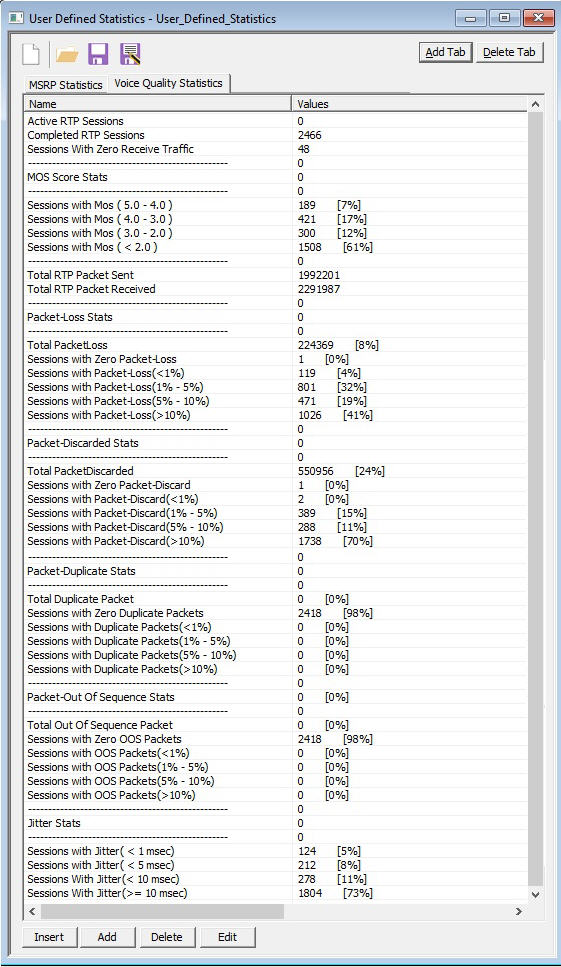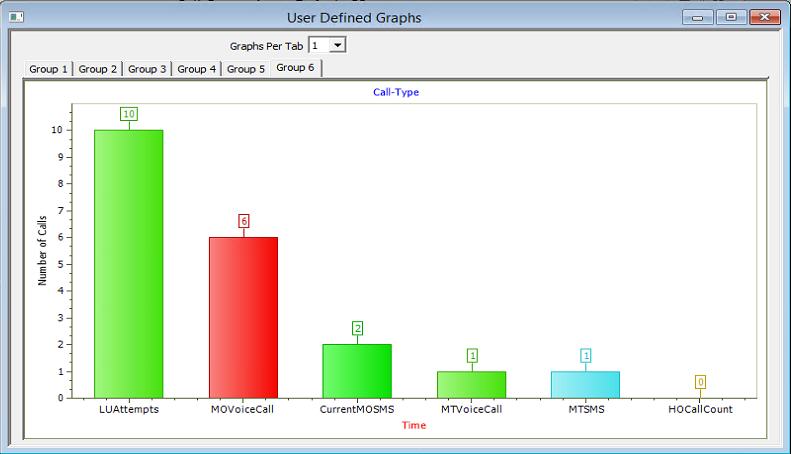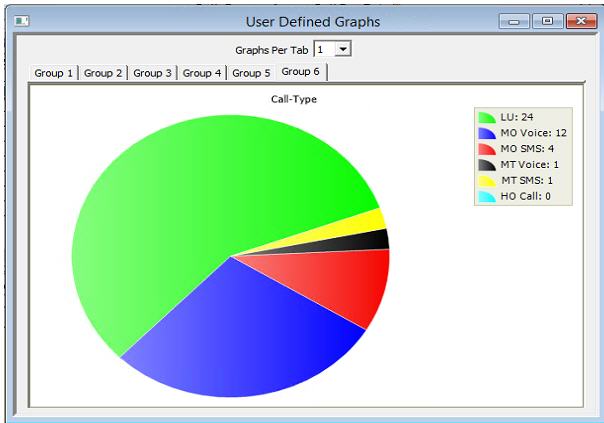RTP Traffic Simulation
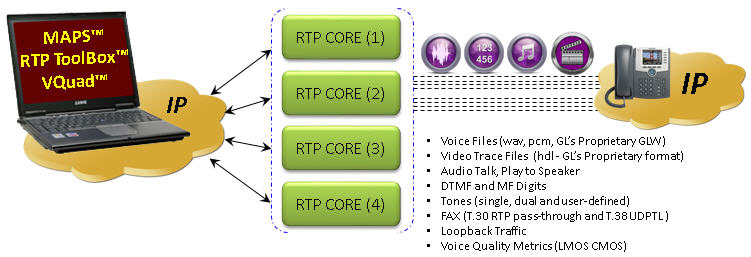
Overview
GL’s RTP Core allows creating, managing and deleting RTP sessions. RTP Core is a stand-alone application that acts as an interface between RTP Dll and the integrating applications such as GL’s MAPS™, VQuad™, and RTP ToolBox™. The product is available with the following options:
- RTP traffic simulation for IMS/IP Network (PKS102, PKS106, PKS107, PKS108, PKS200, PKS211) over SIP, SIP I, MGCP, MEGACO, BICC over IP interfaces
- RTP traffic simulation for Wireless Network (PKS102, PKS103, PKS108, PKS200) over UMTS IuCS & IuH, GSM A and Abis over IP interfaces
RTP Dll uses the RTP protocol to carry the media streams including real-time audio, voice files, video, DTMF/MF digits, tones, IVR, FAX, impairments, and loopback traffic over created sessions. Currently, RTP video traffic simulation is supported in MAPS™ SIP application only. RTCP is used to monitor transmission statistics and quality of service (QoS). Different RTCP packets are also generated at random intervals carrying all control information about the session.
GL’s RTP Core provides option to run pre-defined RTP Action Scripts automating the traffic actions to be performed on the sessions. One good example of these scripts is IVR applications.
Customize RTP packet transmission over traffic sessions with the codec type, sampling rate, voice payload type, RFC 2833 payload type, comfort noise payload type, packetization time (ptime), SSRC, timestamp, and sequence number. On receiving session, users can specify the jitter buffer size and the amount of delay. On Tx session, users can also assign Quality Of Service (QoS) control values, such as precedence, delay, throughput, and reliability to the stream.
Additionally, GL's PacketScan™ provides the ability to monitor / record signaling, audio (wav files), and video (in QuickTime *.qt format) data over IP network to perform powerful audio/video analysis per call.
With the purchase of RTP Core license (PKS102), MAPS™ supports transmission and detection of various RTP traffic such as, digits, single tone, dual tones, FAX, IVR, and voice. With additional licenses, Video (PKS106) and Fax traffic can also be simulated over the established RTP sessions. Currently, RTP Video simulation is supported in MAPS™ SIP only. The RTP core also provides useful voice call quality metrics such as Listening and Conversational Quality MOS scores - MOS-LQ, MOS-CQ, and Listening and Conversational Quality R factors - R-LQ, R-CQ. Estimates are based on the ITU G.107 E Model.
With GL’s HD RTP traffic generation capability (PKS109), MAPS™ can achieve high volume calls. This requires a specialized 2U rack system with integrated HD NIC (w/ 4x 1 GigE). MAPS™ HD RTP network appliance can easily achieve more than 20,000 endpoints per appliance (5000 per port).
For more details, please visit Packetscan™ All IP Packet Analyzer webpage.
Main Features
- Create, manage RTP sessions and generate and receive RTP traffic over the sessions with complete automation capability
- Transmit and receive pre-recorded video traces with video codecs like H.264, H.263 etc. **
- Transmit and receive pre-recorded voice files, and live voice
- RTP based Voice Quality (MOS and R-Factor) measurement for the received streams
- Customize codec options (payload type, ptime) over Tx/Rx sessions. All Voice Codecs are supported (Visit Voice Codecs webpage for more comprehensive information).
- Talk using Microphone - allows the user to generate live voice
- "Play to Speaker" streams voice to a speaker
- Transmit and receive FAX files in T.30 pass-through mode. Fax over UDPTL transport using T38 protocol (compliant with ITU-T T.38 (03/2002)) operates at the maximum of 33.6 kbps speed **
- Loopback real-time voice traffic (all received traffic is retransmitted as sent traffic)
- Generation and Detection of RTP Events per RFC-2833 & RFC-4733 such as Answering Tone, Calling Tone, Special Dial Tone and other Call Progress Tones
- Generation of user-configurable impairments over established RTP calls such as
- Latency - Fixed, Uniform, and Normal Distributed
- Packet Loss - periodic, random, and burst
- Packet Effects - Out-of-order and Duplicate packets
- Supports RTP traffic implementation over Iu-UP (Iu User Plane Interface) layer of the UMTS IuCs Network **
- Supports RTP traffic as per ED-137B of EUROCAE standards used for voice communication in Air Traffic Control networks *
- Calculates and provides RTP voice quality metrics such as Listening MOS, Conversational MOS, Jitter, delay, lost packets, duplicate packets, discarded packets, and out of order packets on each session
- Detailed statistical information of RTP and RTCP packets
- Jitter Buffer implementation for the received traffic to give near real time affect
- Different RTCP packets are also generated at random intervals carrying control information about the session.
- In-band Digit transmission & detection (DTMF and MF digits)
- Out-band Digit transmission & detection (all events defined as per RFC2833 and RFC4733)
- Tone transmission & detection (single, dual and user defined tones)
- Loopback traffic
- Supports High Density RTP Traffic Generation (requires PKS109 licenses)
** Some of these features requires additional licenses – contact GL for more information
Working Principle
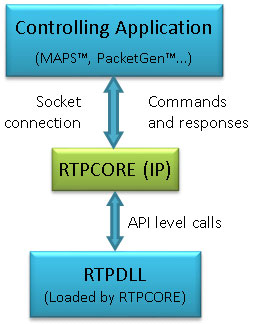 |
RTP Core is a stand-alone application that acts as an interface between RTP Dll and the application. RTP Dll is the RTP server that allows creating, managing, and deleting RTP sessions. GL's protocol simulation applications such as VQuad™, RTPToolBox™, MAPS™, and others support RTP Core. Basically applications and RTP Core act as client and server respectively and communicate using socket connection. The advantage of the socket communication is that it allows traffic load distribution across different systems running RTP Core and the applications. Each application can connect to multiple RTP Core running on same system or different systems. However, multiple applications cannot connect to a single RTP Core. RTP Core listens on TCP port 30102 for connection from application. |
Bulk Voice Traffic Simulation
RTP core can generate and receive voice traffic over IP networks and can work with applications such as GL’s MAPS™, VQuad™, and RTP ToolBox™ (PKS102). Transmit and Receive pre-recorded Voice Files in wave, pcm, and GL's proprietary pre-compressed GLW files with a synchronous Tx/Rx option. You can also directly send live voice using Talk using Microphone feature, and play the recorded voice files directly on to PC speakers. Some additional features that help in the voice traffic simulation are listed below-
- Allows to specify a desired voice payload type to each codec for sending and receiving payload;
- Sampling rate of the codec is displayed for the selected codec.
- Comfort noise generation is supported for A-law, µ-law and G.726 codecs for sending and receiving payload.
- Allows to set the buffer used for delayed packets that arrive at receiving end (both static and dynamic jitter buffers are supported)
- Allows to set QoS (Type of Service) properties such as precedence, delay, throughput and reliability values to the outgoing stream
- Comprehensive voice codec support -
- G.711 (A-law / Mu-law - 64kbps)
- G.711 App II (A-Law and Mu-Law with VAD Support)
- G.722
- G.722.1 (32 k and 24 k)
- G.729, G.729B (8 kbps)
- G.726 (5 bit 40kbps/4 bit 32kbps/3 bit 24kbps/2 bit 16 kbps)
- G.726 (40/32/24/16 kbps with VAD)
- GSM 6.10 (13.2 kbps)
- GSM-HR (rate – 5.6kbps)
- GSM-EFR (rate - 12.2kbps, packet time fixed at 20msec.)
- SPEEX (Packet time fixed to 20msec)
- SPEEX_WB (Packet time fixed to 20msec)
- iLBC
- iLBC_13_33
- SMV (Modes - 0, 1, 2 and 3- Available if licenses are provided or owned, please call GL)
- AMR (4.75kbps, 5.15kbps, 5.9kbps, 6.7kbps, 7.4kbps, 7.95kbps, 10.2kbps, 12.2 kbps) (optional codec)
- AMR_WB
- EVRC (Rates - 1/8, ½ and 1) , EVRC0 (optional codec)
- EVRC_B (Rates - 1/8, ¼, ½, and 1), EVRCB0 (optional codec)
- EVRC_C (optional codec)
- H.263 video capture and conference capability
- H.264 video compression codec
For more details, please visit Voice Codecs webpage.

Bulk RTP FAX Simulation (T.30 pass through and T.38 UDPTL)
GL offers a variety of test tools to perform FAX over IP (FoIP) simulation and monitoring. Fax simulator supports both RTP G.711 Pass Through Fax Simulation (PKS200) and T.38 Fax Simulation over UDPTL (PKS211). Almost all MAPS™ IP based simulation products supports FAX simulation using any of these two methods. Typical applications of our Fax Simulators include load testing of fax servers, qualification testing of T.38 Gateways, testing of ATAs (Analog Terminal Adapters), testing of internet-aware fax machines, and many more.
With respect to channel capacity RTP pass-through and T.38 fax simulation over UDPTL supports up to 120 concurrent Fax channels.
Almost all MAPS™ IP products support fax simulation – MAPS™ SIP, MAPS™ SIP-I, MAPS™ MEGACO, MAPS™ BICC, MAPS™ GSM, and MAPS™ UMTS.
MAPS™ allows the user to initiate fax calls by sending call control messages using proper scripts and profiles. The profile allows necessary parameters of call control messages to be changed during runtime. The below figure depicts the T.30 fax call being generated using MAPS™ SIP.
GL’s RTP Fax Simulator simulates multiple fax calls over IP in T.30 pass through mode (using G.711 PCMU and PCMA). It can transmit pre-recorded Tiff image to DUT (Real-time Fax machine), receive Pass-Through fax from DUT, and record complete fax call messages as log file along with a Tiff image.
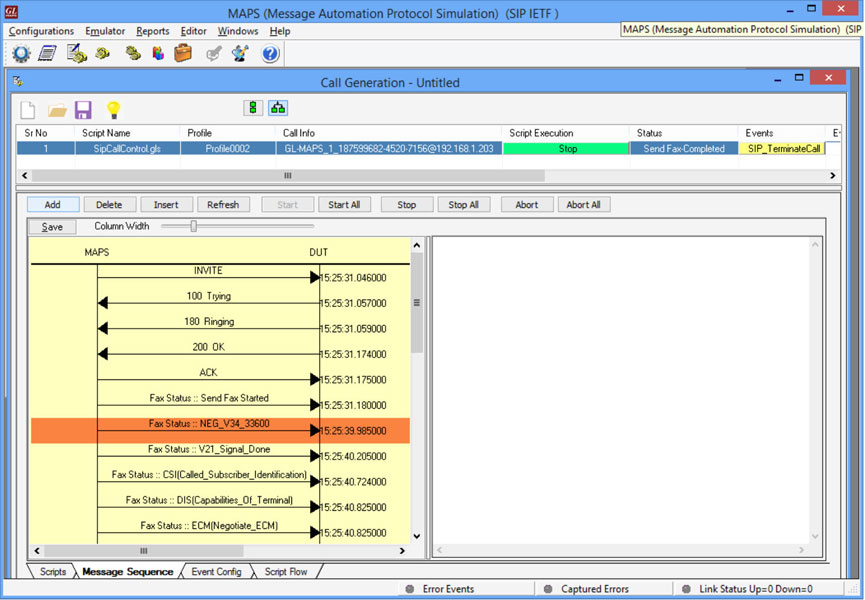
T.30 G.711 Pass through mode FAX simulation using MAPS™ SIP
MAPS™ SIP generates Re-Invite to switch from audio mode to image (FAX) mode. While the call in progress, the MAPS™ also provides events related to the progress of the call. After completion of the call, MAPS™ provide call quality statistics.
GL’s RTP Fax over UDPTL transport simulates multiple fax calls over IP using T38 protocol (compliant with ITU-T T.38 (03/2002)) up to maximum of 33.6 kbps speed.
The below figure depicts the T.38 fax call being generated using MAPS™ SIP.

T.38 Fax call in progress
Bulk Video Traffic Simulation
MAPS™ SIP provides the Bulk Video Call Simulation capability using its pre-recorded video traces supporting codecs like H.264, H.263, & VP8. On a high-performance computing platform (core-i7), it is possible to generate more than 500 simultaneous video calls. With a High Density (MAPS™ HD)platform, it is possible to achieve much more capacity. H.263 provides video capture and video conference monitoring capability, while H.264 is an industry standard codec for video compression. H.264 codec offers better compression performance over previous standards.
Below figure depicts the bulk video call simulation and RTP video transmission in MAPS™ SIP. Observe the decode part of the INVITE message showing the information about the audio and video codecs used in the request.

Bulk Video Call Simulation in MAPS™ SIP
RTP/RTCP Packet Statistics
Statistics reports of RTP and RTCP packets transmitted on a session such as number of packets sent/received, dropped packets, out of sequence packets and more. Sender and receiver reports are also displayed using RTP/RTCP statistics applications.

RTP /RTCP Packet Statistics
Speech Quality Metrics (R Factor & MOS)
With support of additional licensing (PKS108) RTP voice quality metrics for the received calls are calculated and are reported to MAPS™ application. Quality metrics include R-Factor, Listening and Conversational Quality MOS scores, PacketLoss, Discarded Packets, Out of Sequence Packets and Duplicate Packets.
R Factor graph will display statistics such as, R-Listening, R-Conversational, R-G107 and R-Nom. MOS Factor graph will display statistics such as MOS CQ, MOS PQ and MOS Nom. Estimates are based on the ITU G.107 E Model.
A typical estimate of the MOS and R-Factor scores for each codec is available in Voice Codecs webpage.
GL’s MAPS™ application provides a feature which helps users to customize the global statistics for RTP audio and video traffic. These global parameters are defined in the call generation scripts, which are calculated and updated periodically providing call quality metrics such as Listening MOS, Conversational MOS, PacketLoss, Discarded Packets, Out of Sequence Packets, Duplicate Packets, Delay and Jitter as shown in the figure below.
Audio File Converter Utility (AFCU)
GL’s Audio File Conversion Utility (Audio FCU) is generally used in conjunction with GL Packet Series products to further enhance send and record voice file capabilities. This utility supports almost all industry standard voice codec data formats, that helps to convert recorded voice files from their native codec format to a GL standard format. This enhances the applications’ ability to send/receive voice files at a higher density with multiple codecs option.
The utility also helps convert raw linear voice files/wave files from an Intel voice data format to a compressed GL Proprietary transmission format (*.glw) and vice versa. For more details on supported codecs, refer to Voice Codecs.
The utility supports both 32-bit and 64-bit applications. It provides flexible options to convert Single or Multiple audio files for all or any of the supported codec types and stored in appropriate pre-defined sub-directories. The Command line interface (CLI) in AFCU allows the users to load, start, and stop Auto FCU configurations, convert glw to PCM and vice-versa.
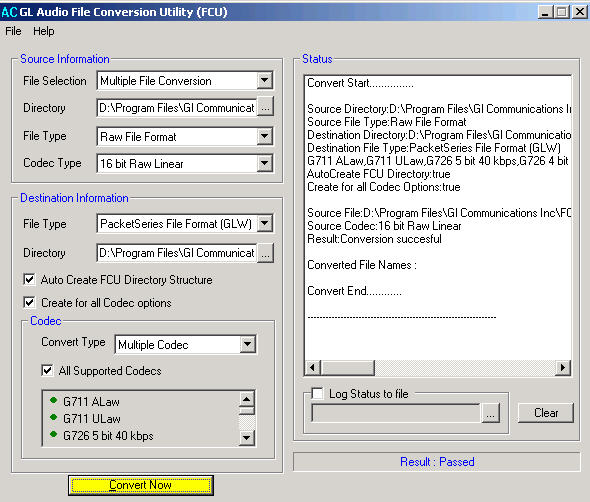
Audio File Conversion Utility (AFCU)
Speech Transcription Server
GL’s Speech Transcription Server is a PC-based automated speech-to-text conversion application. Among numerous applications, the Speech Transcription Server can be used for confirming voice prompts (announcements) and aid in testing Interactive Voice Response (IVR) systems as well as voice transportation over any network. Network providers use the application to record the voice prompts associated with the IVR, perform a Speech to Text conversion on the recording to confirm the prompt was proper (based on what the prompt should be), and thus confirming their IVR functioning. The application can be used to verify network quality as well as effect of different codecs on the speech quality.
For more details, refer to Speech Transcription Server webpage.
SMS Traffic Simulation
MAPS™ also supports sending and receiving SMS (Short Message Service) using signaling channel simultaneously with other voice and data services over a GSM, UMTS, or MAP interfaces. MAPS™ has the ability to push / pull Short Messages over the network as if sent by thousands of mobile phones (Short Message Mobile Originated (SMS-MO)). MAPS™ can also transmit a Short Message to a mobile phone (Short Message Mobile Terminated (SMS-MT)). The short message service testing is available on the GSM, UMTS, and MAP interfaces. GL’s 2G, & 3G Wireless Lab setup supports end-to-end SMS calls simulation in Circuit Switch (CS) network.
This feature is supported in MAPS™ GSM A over IP, MAPS™ MAP, and MAPS™ UMTS IuCS & IuH applications.
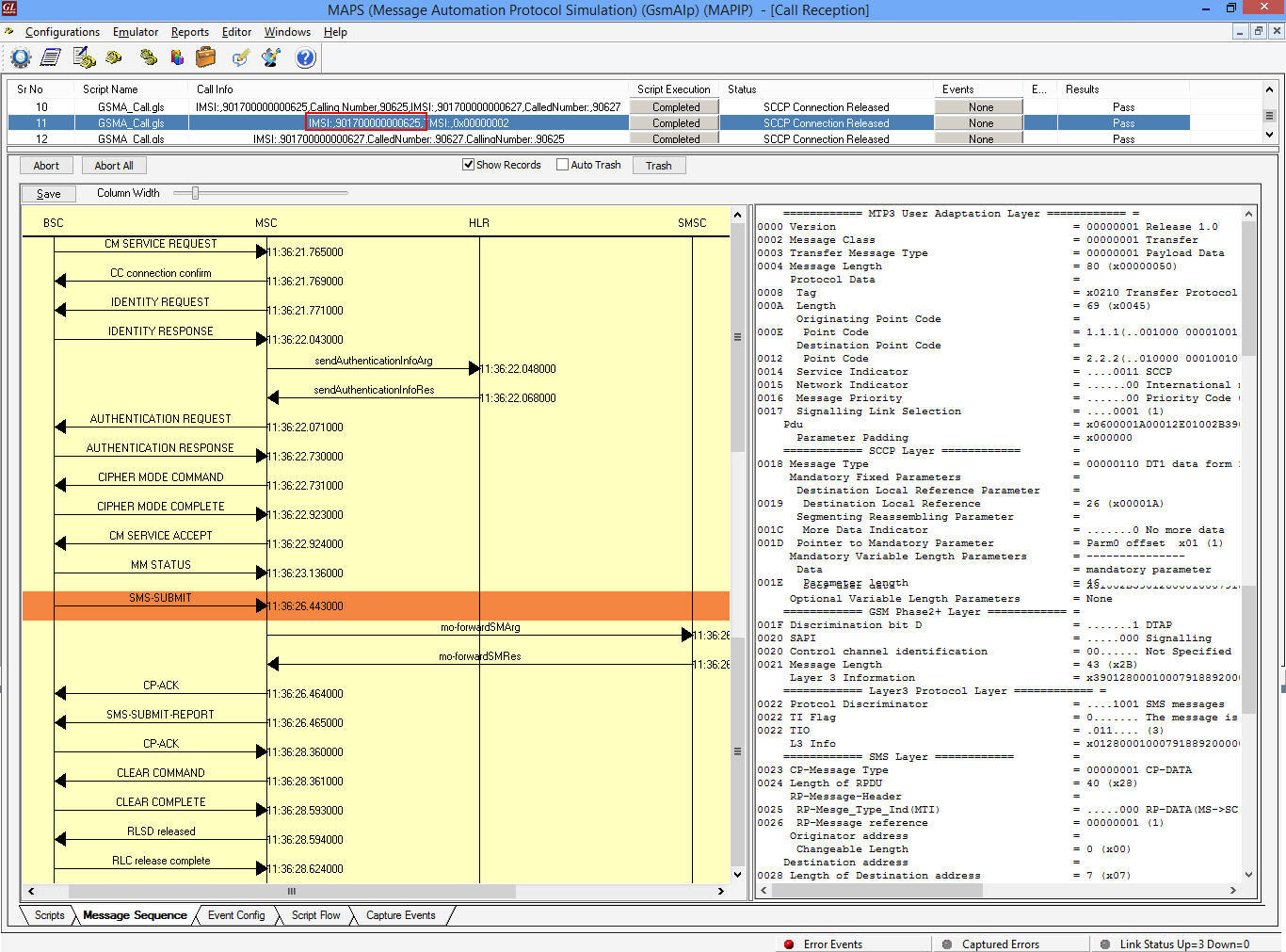
Speech to text Interactive Voice Response (IVR) Test Solution
MAPS™ SIP with GL's Speech Transcription Server provides automated IVR testing by using speech to text to navigate through an IVR tree. IVR prompts are recorded by MAPS™ SIP and transcribed by the Speech Transcription Server. Transcribed text is compared to an expected text at each IVR stage to confirm the prompt.
Once the IVR prompt is confirmed, MAPS™ sends DTMF or voice-based responses to move to the next stage. The expected IVR prompts and responses are defined by the customer to ensure completely customizable tests that are suitable for all IVR systems.

The below diagram illustrates the IVR tree of GL's main telephone number as an example:
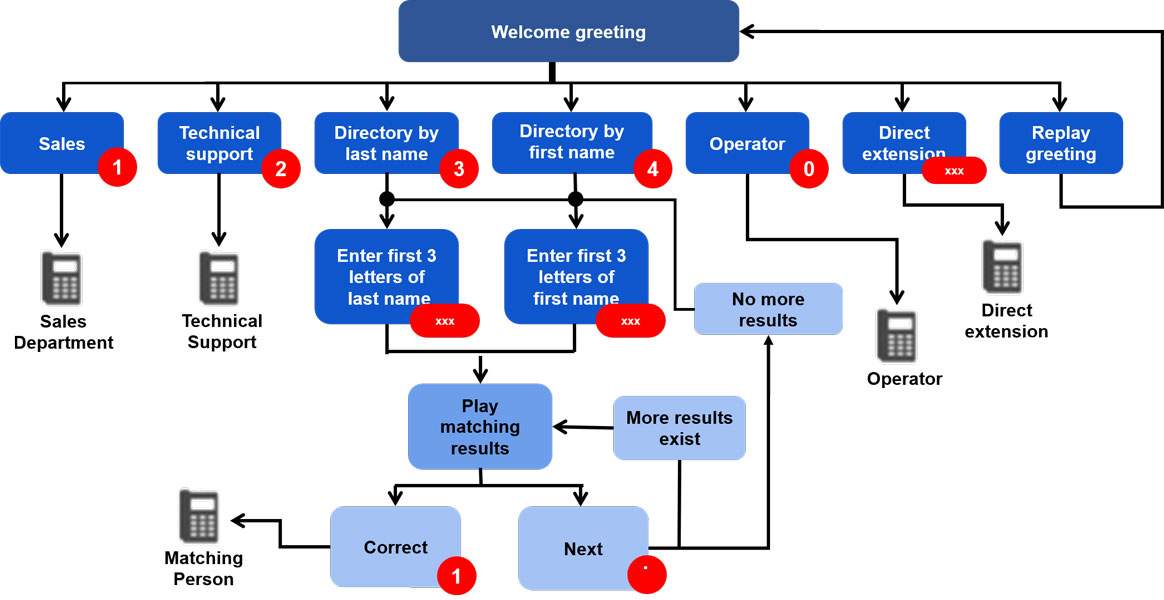
Tests can be started on the selected profile through Call Generation or through Load Generation. There is a max limit of 20 concurrent calls that can be processed for each MAPS™ SIP system. IVR tests start automatically once the call is established - i.e. the 200 OK is received. The Message Sequence tab (only available when call is placed through Call Generation) shows each step of the IVR test, including the prompt received and the traffic action sent.
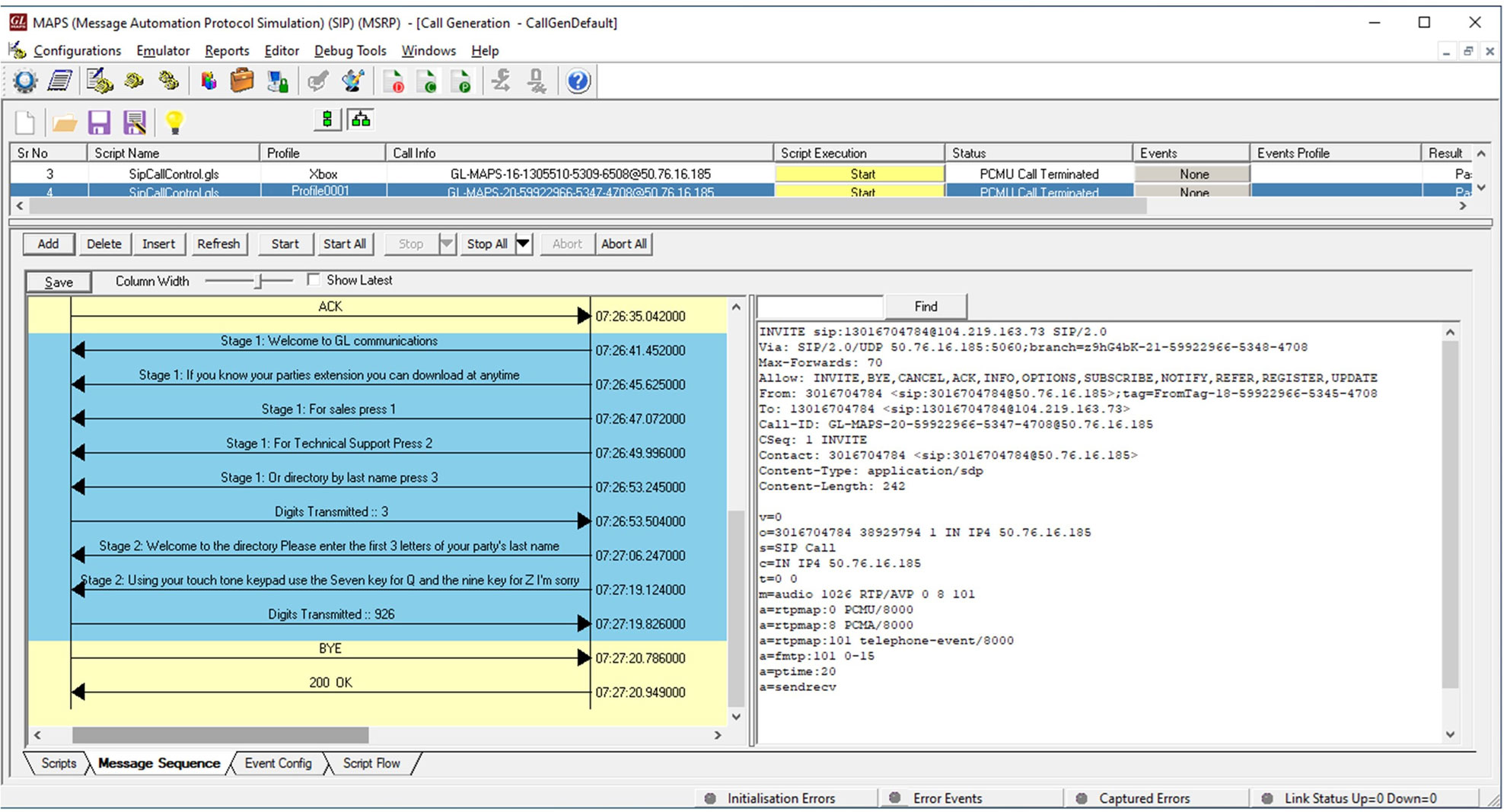
Resources
Note: PCs which include GL hardware/software require Intel or AMD processors for compliance.
| Item No. | Item Description |
|---|---|
| PKV100 | PacketScan™ (Online and Offline) Includes SIP, RTP, H.323, MGCP, MEGACO, Skinny, ED-137 |
| PKV101 | PacketScan™ - Offline |
| Related Software | |
| PKS102 | RTP Soft Core for RTP Traffic Generation |
| PKS109 | MAPS™ HD RTP (Requires 4x1 GigE HD NIC) |
| PKS111 | |
| PKS112 | Message Session Relay Protocol for MAPS-SIP |
| PKS170 | CLI Support for MAPS™ |
| PKV110 | |
| PKV107 | LTE (Long Term Evolution) Analyzer (Optional with PacketScan™) |
| PKV108 | Offline LTE (Long Term Evolution) Analyzer (Optional with PacketScan™) |
| PKV112 | 5G Analyzer (Optional with PacketScan™) |
| PKV113 | Offline 5G Analyzer - Optional with PKV101 (offline PacketScan™) and PKV170 (NetsurveyorWeb™) |
| PKV105 | SIGTRAN (Optional with PacketScan™) |
| PKV106 | Offline SIGTRAN Analyzer (Optional with PacketScan™) |
| PKV103 | IP Based GSM and UMTS Analyzer (Optional with PacketScan™) |
| PKV109 | Offline IP Based GSM and UMTS Analyzer (Optional with PacketScan™) |
| PKV104 | FaxScan™ for SIP and Fax over IP (T.38) |
| PCD103 | AMR Codec - Narrowband (requires additional license) |
| PCD104 | EVRC Codec (requires additional license) |
| PCD105 | EVRC-B Codec (requires additional license) |
| PCD106 | EVRC-C Codec (requires additional license) |
| PCD107 | AMR Codec - Wideband (requires additional license) |
PCD108 |
Optional Codec - EVS (requires additional license) |
| PCD109 | Optional Codec - Opus (requires additional license) |
| PKV120 | PacketScan™ HD w/4 x 1GigE |
| PKV120p | PacketScan™ HD w/4 x 1GigE - Portable |
| PKV122 | PacketScan™ HD w/2 x 10GigE |
| PKV122p | PacketScan™ HD w/2 x 10 GigE - Portable |
PKV124 |
|
PKV124P |
|
| PKV123 | PacketRecorder™ HD & PacketRePlay™ HD |
| PKB100 | RTP ToolBox™ Application |
| PKS120 | MAPS™ SIP Emulator |
| PKS120 PKS122 PKS124 PKS160 PKS137 PKS126 |
MAPS™ SIP Emulator MAPS™ MEGACO Emulator MAPS™ MGCP Emulator MAPS™ UMTS IuCS, MAPS™ UMTS IuH MAPS™ GSM A over IP MAPS™ SIP I |
| VQT002 | Voice Quality Testing (PESQ only) |
| VQT006 | VQT w/ POLQA Server license (no limitations) |
